|
Car Musings (2018)
Trompe L'Oeil Impala: A 1958 Chevrolet Impala, exhibited at SEMA last week, is not what it seems to be. Looking like a bare-metal finish automobile decorated everywhere with etchings, engravings and machine turnings is actually a paint job.
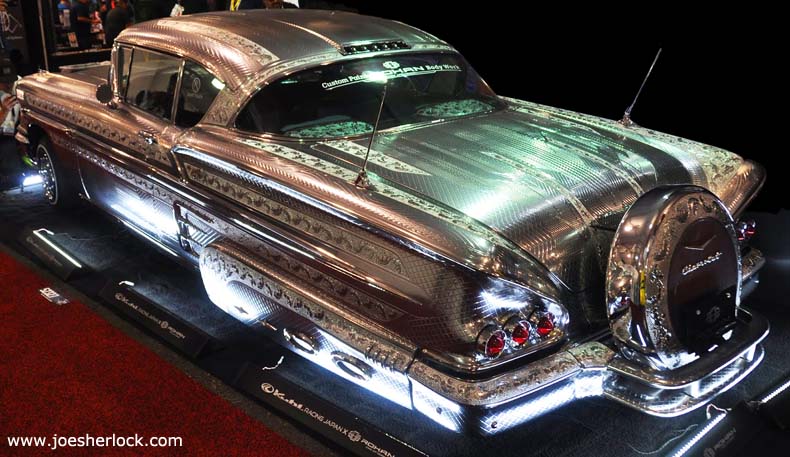
Displayed by Kuhl Racing and Japanese paint and automotive parts producer Rohan, the car showcased the artistry of custom painter Takahiko Izawa, who is credited with the invention of "metal paint" and for his unprecedented technique of "engraving" an entire car body.
Izawa reportedly uses various stencils and spends hours applying and sculpting the painted surfaces to achieve a awesome 3-D effect. The result is spectacular. There are lots more photos at Jesse Bowers' Just A Car Guy site. (posted 11/9/18, permalink)
Book Review: 'Ultimate Speed: The Fast Life and Extreme Cars of Racing Legend Craig Breedlove' by Samuel Hawley
If you're an Indianapolis 500 enthusiast, there's a nice museum at the Speedway. On some days, you can even arrange to be ferried around the oval. If you like drag cars, there's the Don Garlits Museum of Drag Racing in Ocala, Florida. If you're a fan of Land Speed Record Cars, you're mostly out of luck. You won't find a dedicated museum in Bonneville, Utah or anywhere else. Various museums have one or two cars but that's about it. The Beaulieu Motoring Museum in Southern England has a couple of the Campbell's Land Speed Record cars.
If you read car magazines in the 1960s, Craig Breedlove is a familiar name. Craig was always interested in cars and motorcycles. Born in 1937, he was part of the postwar LA hot rod scene in the early 1950s. He had a high school education but had good seat-of-the-pants engineering skills and built several hot rods, eventually running one at Bonneville. Hooked on speed, awestruck by Mickey Thompson's four-engined Challenger LSR machine and the various Arfon Brothers vehicles, he decided to design and build his own LSR vehicle, the Spirit of America. The story of his quest for speed records what this biography is mainly about.
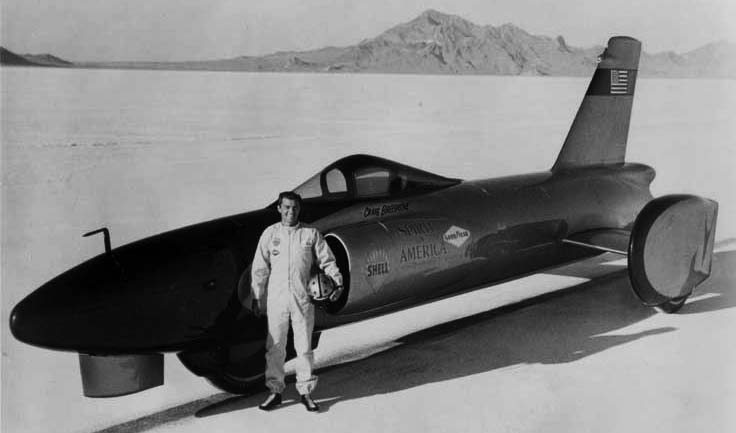
Breedlove lived a tumultuous life. He ... (more >>>)
Book Review: 'Mustang by Design: Gale Halderman and the Creation of Ford's Iconic Pony Car' by Ames Dinsmore and James Halderman
The Mustang is one of the most significant cars of the second half of the 20th Century. Earlier this year, the 10 millionth example rolled off the assembly line. For all its mistakes, Ford has resisted the temptation to make the Mustang something else. No four-door sedans or station wagons (both discussed in this book), no SUV version, no foreign editions made outside America - nothing to sully the purity of this American sporty coupe.
There have been many books written about the marque, this is the first one to focus on ... (more >>>)
Before There Was Tesla Or Prius: The 1942 Oeuf électrique, or electric egg, ran on batteries decades after gasoline became the dominant way to power cars, "and decades before Elon Musk decided to make electricity cool again."
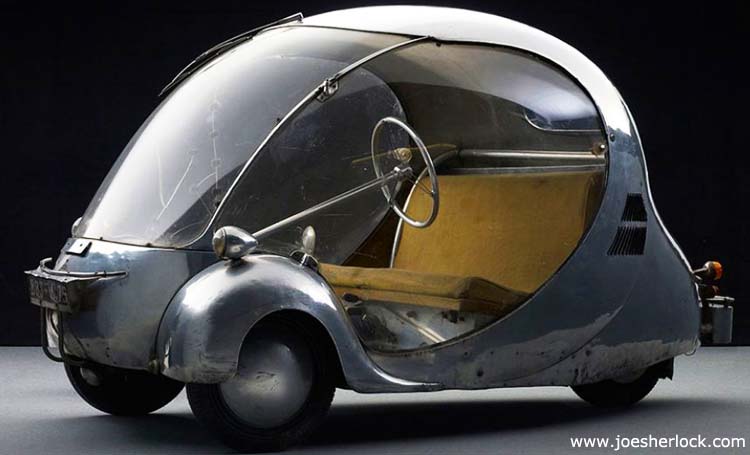
Its designer, Parisian Paul Arzens, worked as a painter and designed railway locomotives before moving on to cars. The bubble was "made of hand-formed aluminum and curved Plexiglas, a novel material at the time." (posted 10/22/18, permalink)
Twenty Years Later: In October 1998, I sold my 1956 Continental Mark II. Earlier this month, I was contacted by one of its present owners. Three owners later, the car has been driven a mere 996 miles since I sold it twenty years ago. In the six years I owned it, I put 2,075 miles on it. And had a lot more fun. It is too bad that most collectible cars end up as display pieces; I believe that cars were made to be driven.
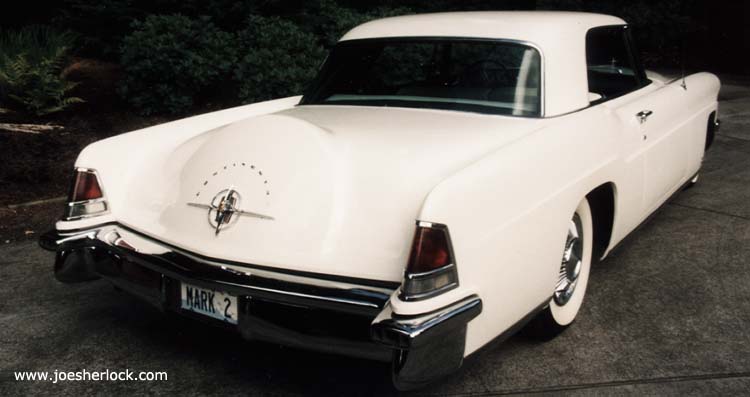
My other Continental Mark II, a 1957 model which I owned from 1987 to 1993, got lots of mileage under my stewardship. I drove it from Corvallis, Oregon to Seattle on several occasions. Drove it from Battle Ground, WA to Bend, Oregon. Also did a round trip to Salt Lake City, another one to St. Maries, Idaho, and still another to Baker City, Oregon and back. The more I drove it, the better it ran. It was a touring car rather than a show car. It looked good from 10 feet away but up close the rubber around the glass was age-cracked and it had many other little (but expensive to fix) cosmetic flaws which prevented it from being a big trophy winner. It made a great tour car and that's what I used it for.
As for the 1956 Mark II, I entered it in the 1994 Lincoln and Continental Owners Club's Western National Meet in Silverdale, Washington. My '56 won the Ford Motor Company Concours Trophy for 'Best '56-'57 Continental Mark II.' At the 1997 Western National Meet in Eagle Crest, Oregon, it was one of two vehicles on display in the banquet room of the hotel. (It was the only time I've ever driven a car down a hotel corridor.)
I'm glad to know that the '56 Connie is still around. I just wish it was out having more fun. (posted 10/18/18, permalink)
Book Review: 'The V12 Engine: The Technology, Evolution And Impact Of V12-Engined Cars' by Karl Ludvigsen
We live in an age where many manufacturers are killing-off their legendary V8 engines, in favor of fewer cylinders. It is therefore a great time to visit the times and siren song of the V12 motors of yore.
There is something special about a V12 motor. In his memoirs, Enzo Ferrari wrote ... (more >>>)
The Devil Is In The Details: That sums up why the Kaiser Darrin sports car was a failure. Also known as the Kaiser Darrin 161, it was an American sports car styled by Dutch Darrin and built by Kaiser Motors for the 1954 model year.
An article in The Old Motor noted, "Howard 'Dutch' Darrin, was an internationally famed American automobile stylist who also operated his design studio in Paris, France for a time. 'Dutch' designed the unique coachwork for the Kaiser Darrin. In the early-1950s, he penned the design for the distinctive Kaiser Darrin sports convertible that featured a fiberglass body shell produced by Glasspar, which featured sliding doors, and a three-position convertible top." The Darrin was conceived as a response to European roadsters being imported to the United States in the early post–World War II period.
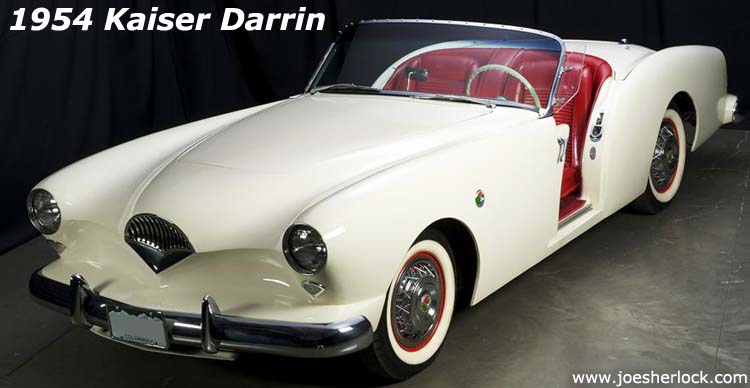
The Kaiser Darrin was essentially a rebodied Henry J. It was one of the first American cars equipped with a fiberglass body and featured pocket doors that slid on tracks into the front fender wells. The K-D rode on a 100-inch wheelbase and was 184 inches long. It was powered by a 90-horsepower Willys F-head six-cylinder engine, with three-speed manual transmission and overdrive. The shift lever was mounted on the steering column. The pocket doors precluded the use of roll-up windows, so side curtains were available for driving in inclement weather. Reportedly, they leaked badly as did the folding roof. The pocket door was prone to jamming if the tracks were not meticulously and frequently cleaned. Details, details.
Only 435 examples were produced. While attractively styled, the Darrin failed because it was underpowered and overpriced. Posted price was $3,668 - more than double what a Henry J cost, yet the K-D shared the same chassis and powertrain. In comparison, the gorgeous Jaguar XK120 roadster cost less than $3,400 in those days and had a 160 horsepower motor. Over 10,000 left-hand drive XK120 were sold - mostly in North America - during the 6-year period ending in 1954.
The 1954 Chevrolet Corvette was priced at $3,523 and offered 150 horsepower. A sharp-looking 1954 Ford Sunliner convertible could be had for a little as $2,339. It had Ford's new-for-54 overhead-valve V8 engine, which produced 130 horsepower. The head-turning, 185 horsepower Oldsmibile Super 88 convertible with its Rocket V8 engine was priced at $2,868.
No wonder so few Kaiser Darrins were sold. As a car-crazy preteen, I was always on the lookout for interesting cars on the road. I never spotted a Kaiser Darrin. Sixty-plus years later, I've never seen one outside of museums or private collections. It is a nicely-styled car, though.
With more realistic pricing, normal doors, wind-up windows and other details, along with a more powerful motor, the Darrin could have been a contender. (posted 10/12/18, permalink)
Book Review: 'Fins: Harley Earl, the Rise of General Motors, and the Glory Days of Detroit' by William Knoedelseder
It is difficult to imagine what the automobile world would have been like without a Harley Earl. Yes, there were other talented stylists: Gordon Buehrig (Duesenberg Model J, 1935 Auburn 851 boattail speedster, coffin-nosed 1936 Cord 810/812), E.T. Gregorie (1936 Lincoln Zephyr, 1939 Mercury, 1940 Lincoln Continental, 1940 Ford), Frank Hershey, Virgil Exner - but all were trained by Mister Earl, as he was known. Edsel Ford was a talented guy who recognized good taste enough to hire some of these designers but he was browbeaten so badly by his father, crazy Henry Ford, that most of his ideas never came to fruition.
Many good designers left General Motors because, while Earl had a good style sense and could squeeze the best out of designers, he was also a tough taskmaster ... (more >>>)
Book Review: 'Classic Racing Engines: Design, Development and Performance of the World's Top Motorsport Power Units' by Karl Ludvigsen
Karl Ludvigsen is an MIT engineer and industrial designer. As a General Motors employee in 1956, Ludvigsen planned experimental front-drive prototypes. He worked in the auto industry for most of his life. Over the years, he has written for many popular car magazines and has authored over four dozen books. I've read his articles in the past and have always been impressed with his depth of subject knowledge.
In this 215-page book (plus a comparison spec table, glossary and index), Ludvigsen reviews 50 different racing engines, covering the period from ... (more >>>)
There's A New Beast Is In Town: The latest presidential state Cadillac limo was unveiled during President Trump's visit to the United Nations in New York. Dubbed The Beast, the vehicle features eight-inch thick doors, a bomb-proof exterior, and an oxygen supply in case of a chemical attack.
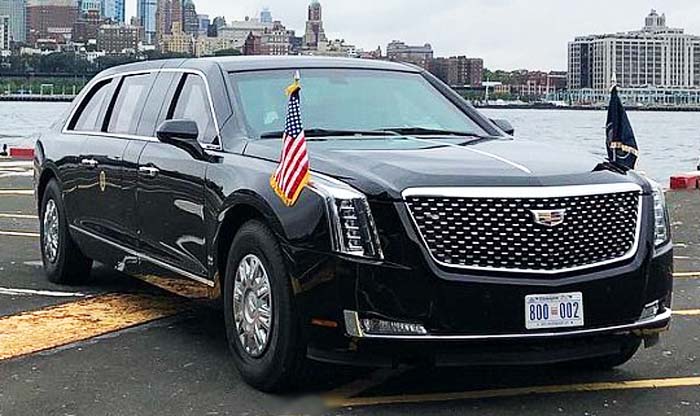
It appears to have the same headlights as the current Escalade SUV and is markedly sleeker that the 2009 model it replaces. The doors of the presidential state cars do not have keyholes with only the Secret Service knowing how to open them. All of the windows are completely sealed and unable to roll down, except for the driver's side to allow him to pay tolls, and are able to withstand armor-piercing bullets and explosions. (posted 9/26/18, permalink)
Book Review: 'Volkswagen Beetle: A Celebration of the World's Most Popular Car' by Richard Copping
 The Volkswagen story is so unlikely that it sounds like the script for a Mel Brooks movie: Adolph Hitler orders a car for the German masses. The Nazi high command has it designed and prototyped. Hitler calls it the People's Car. Only a few examples are made before World War II begins. Germany loses the war. The tooling for the car is offered to Henry Ford II who laughs and turns it down, believing the car has no commercial future. Other auto manufacturers are similarly disdainful. Germans begin to assemble the car in the ruins of its bombed-out factory. The Volkswagen story is so unlikely that it sounds like the script for a Mel Brooks movie: Adolph Hitler orders a car for the German masses. The Nazi high command has it designed and prototyped. Hitler calls it the People's Car. Only a few examples are made before World War II begins. Germany loses the war. The tooling for the car is offered to Henry Ford II who laughs and turns it down, believing the car has no commercial future. Other auto manufacturers are similarly disdainful. Germans begin to assemble the car in the ruins of its bombed-out factory.
From that same factory, the People's Car, Volkswagen, is slowly resurrected. For several years, there was a three-month waiting list to buy the little German Beetle. The strange design remained basically unchanged for over five decades. Many of the quirks were still there 50 years later. Shortcomings in the Beetle took forever to correct. Detroit changed over to ... (more >>>)
I'm Not A Boat Guy ... but this certainly caught my eye:
2018 Monterey Week: Last week's annual car festival offered the usual mix of spectacular and fascinating vehicles on display as well as always-interesting auto auction results. Once simply the Pebble Beach Concours, this car-centric, scenic venue has been expanded to include week-long events, including exclusive new vehicle launches by manufacturers as well as numerous track and rally events And humongous traffic jams as people try to attend every attraction.
For those new car buyers with roughly $6 million burning a hole in their pockets, Bugatti unveiled the 1,500 horsepower Divo, which boasts a top speed of 261 mph. The Divo is named after one of the great early Bugatti race drivers, in this case, Albert Divo, who drove a Bugatti Type 35 to victory – twice – in the Targa Florio. Unfortunately, the name conjures up Divco, the milk delivery truck for me. I can almost hear the clink of glass bottles as the Divco-in-my-memory rattles down the street.
Then there were the auctions:

A red 1962 Ferrari 250 GTO - one of just 36 built - boasts successful period racing history, including winning the 1962 Italian National GT Championship and 1st in class at the 1963 and 1964 Targa Florio. The original, numbers-matching 250 GTO was sold by RM Sotheby's for $48.4 million. Dave Burge tweeted, "Personally, if I had $48 million to spend on cars, I'd buy 1000 $48,000 cars." I dunno ... maybe I'd buy 100 $480,000 cars. Dave added, "The crazy thing is I think Enzo Ferrari agreed in 1963 to sell the entire Ferrari operation to Ford (before the deal famously blew up) for $25 million, or around $210 million in today's money. That's roughly the same price as the last four '62-'63 GTOs that have sold."
Additionally, RM Sotheby's sold a 1963 Aston Martin DP215 Grand Touring competition prototype for nearly $21.5 million and the third-place finisher of the 1966 24 Hours of Le Mans – a 1966 Ford GT40 Mk II – for $9.8 million, as well as the 2013 Pebble Beach Concours d'Elegance Best-in-Show winner – a 1934 Packard Twelve Series 1108 Dietrich Convertible Victoria – sold for $3.7 million:
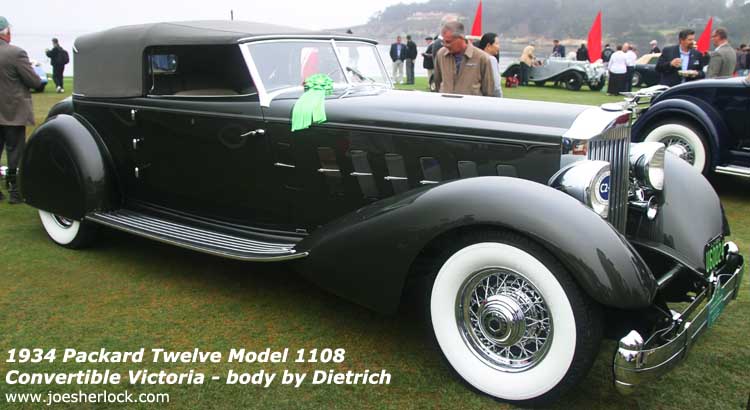
That's a somewhat high price for a Packard but a real bargain for a Pebble Beach Best of Show winner. Sotheby's also sold a 1948 Tucker 48 Sedan for $1,820,000.
At Worldwide Auctioneers, a burgundy 1931 Duesenberg Model J Derham-bodied Tourster fetched $1,320,000. The auction firm also sold a chrome-laden 1958 Buick Limited convertible for $181,500. Why so much? Maybe it had seven headlights like the Buick at the top of this page.
Gooding & Co. sold Gary Cooper's two-tone gray, supercharged 400-horsepower 1935 Duesenberg SSJ LaGrande roadster - one of only two Duesenberg SSJ models ever built, constructed on a specially shortened 125-inch wheelbase - for $22 million. That makes this Duesey the most expensive American car and the most expensive pre-war car ever sold at auction. Gooding also auctioned a silver 1955 Porsche 550/1500 RS Spyder for $4,455,000.
Mecum Auctions were televised. While I found myself compulsively hitting the fast-forward button every time some hideous, giant-wheeled resto-mod Chevelle, Camaro, Mustang or Dodge Dart crossed the block, there were several vehicles caught my eye:
• A 1929 black Duesenberg Model J convertible sedan with body by Murphy crossed the auction block for $1,050,000. I recognized this fine Duesey because I saw it up close during a visit to a personal collection on Washington state's Olympic Peninsula in the 1990s.
• A 1936 Cadillac Series 75 convertible sedan with dual side mounts, finished in a silvery-gray color, sold for $45,000. The car was powered by a 346 cubic-inch flathead V8 which made 136 horsepower.
• An elegant, pale-yellow 1940 Packard Super Eight Convertible Sedan with dual side mounts, once owned by Hollywood producer Billy Wilder, was sold for $135,000.
• A 1941 Plymouth P12 Special Deluxe woody wagon, finished in white, failed to sell at a high bid of $72,000. A maroon example found a buyer at $57,500. Originally priced at $1,031 new, a total of 5,394 of these woodies were manufactured in '41.
• A burgundy 1949 Cadillac Series 62 convertible crossed the block at top bid of $51,000. When new, this Cadillac was priced at $3,442.

• A 1953 Cadillac Series 62 gray convertible, with red leather interior, found a buyer at $60,000.
• A 1953 cream-colored MG TD roadster sold for $12,500. Later, an almost identical 1952 model fetched $21,000.
• A 1955 Oldsmobile Super 88 convertible in this popular color combination sold for $38,000.
• A handsome 1957 Maserati 3500 GT coupe (with 270 hp, DOHC 6-cylinder engine), finished in a light blue exterior with saddle interior, found a buyer at $157,500.
• A 1957 Porsche 356A Speedster, finished in red, sold for $360,000.
• A 1960 Mercury Park Lane convertible, finished in Medium Javelin Bronze, sold for $105,000 - a surprise because 1960 was not one of Mercury's memorable model years, style-wise. Priced at $4,018 when new, only 1,525 of these ragtop Mercs were produced in '60.
• A 1962 Porsche 356B Super Coupe, fully-restored, painted Oscar Blue with optional chrome wheels, sold for $130,000.
• A 1963 Chevy Corvette roadster (like the one I used to own), this one finished in red and powered by the 300 horsepower, 327 cubic-inch V8 and four-speed transmission, sold for $39,000.
• A 1963 Volkswagen 23-window Samba Bus, finished in white over red, crossed the block at $155,000. Another '63 VW Bus in white over light turquoise fetched $170,000. People can't seem to get enough Bus Love these days.
• A 1967 Austin-Healey 3000 Mark III roadster, finished in light blue and beautifully restored, sold for $100,000. A good-looking British Racing Green example fetched $65,000.
• A 1967 British Racing Green Sunbeam Tiger Mark II roadster with the 289 cubic-inch Ford V8 engine fetched $150,000. My good friend Bill B. had one of these as his daily driver in the early 1970s and said it was "wicked fast."
• A 1967 red Triumph TR4 convertible sold for a very reasonable $15,500. My good friend the late Bob Wetzel used to own a red TR4 in the mid-1960s.
• A 1969 Rosso Corsa (red) Lamborghini Miura P400 S sold for $1,050,000. I remember the first time I saw a Miura roar by me on the Pennsylvania Turnpike in the early '70s. It was a lime-green head-turner. A Miura still turns heads today; designer Marcello Gandini's sleek styling has withstood the test of time.
• A 1978 green Ford Pinto Squire Wagon in excellent original condition, with factory faux-wood side paneling, found a sucker buyer at a remarkably outrageous $30,000. In '78, new ones were stickered at $4,343 but - given the nation's economy at the time - you could probably dicker one down to a much lower out-the-door price.
• A 1985 faux Ferrari - the red one used in the movie, 'Ferris Bueller's Day Off' - sold for $370,000.
Overall sell-through rate for all auction companies was 61% this year, up from 59% in 2017, according to Haggerty. However, the sell-through rate for those very expensive 8-figure cars was 80%, moving down to only 58% for 7-figure cars, a big drop from a 70% sell-through a year ago. At the moment, the collector market favors the best cars, but there are signs of weakness just below the summit. Except, apparently, for 5-figure Ford Pintos.
At Sunday's Pebble Beach Concours, the pinnacle and conclusion of the Monterey Week experience, the much-coveted Best of Show was awarded to a black 1937 Alfa Romeo 8C 2900B Berlinetta, with aluminum body by Touring. Powered by a supercharged 2.9-liter inline eight-cylinder engine, the 8C 2900B made 180 horsepower.
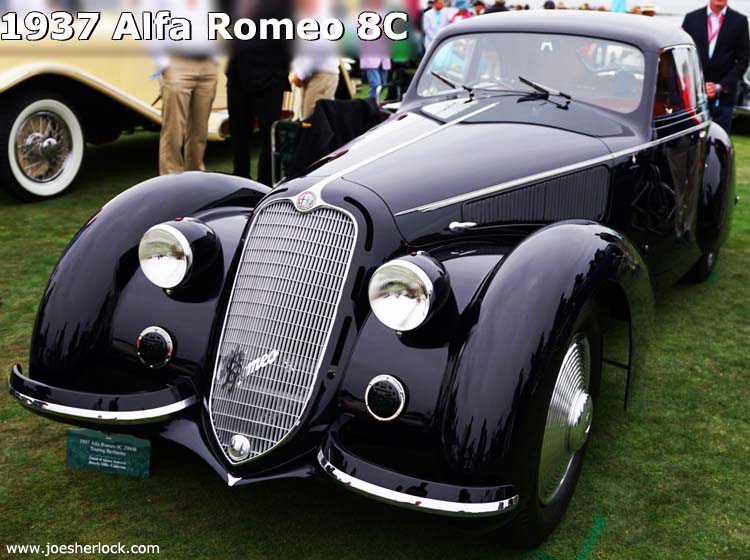
The Alfa is currently owned by David and Ginny Sydorick. It debuted at the 1937 Milan Auto Show, and then was shown at the 1938 Berlin Motor Show. The car was also featured in the Alfa Romeo sales brochure as the 'Coupe Leggero'. (posted 8/28/18, permalink)
Milestone For A Pony: The Ford Mustang - an iconic American brand and a symbol of cool - reached a major milestone last week as the 10 millionth vehicle - a Wimbledon White GT convertible (not a standard paint color in 2019) with black interior, echoing the color scheme of the very first Mustang - rolled off an assembly line at Ford's Flat Rock assembly plant in Michigan. This milestone car was equipped with a 460-hp 5.0-liter V8 coupled to a six-speed manual transmission. The Mustang, celebrated in American song and film and recognized the world over as an iconic American cultural export, will get a big party at Ford's Michigan headquarters.
"It's a turning point for the carmaker, which is banking on the Mustang's wide appeal to help it grow global market share. U.S. sales of the Mustang are dropping, but they are accelerating overseas in markets such as China and Germany. The company also says the car is the best-selling coupe in China, which by 2025 is projected to have twice the share of the global car market compared to the U.S."
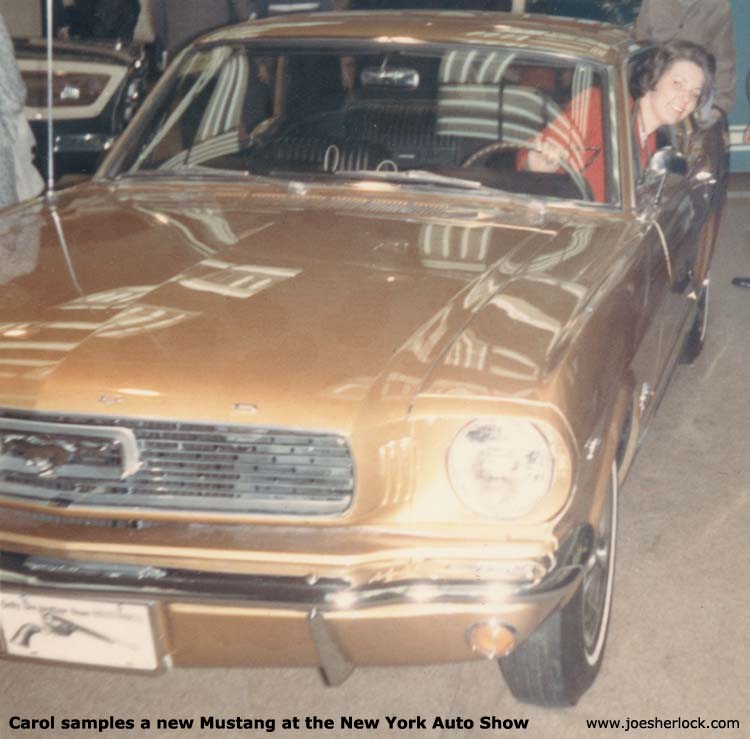
To celebrate the milestone, Ford is appealing to the sense of nostalgia for what is seen as the original "freedom vehicle" that exemplified Americans' love of the open road. After all, the car was named after a horse that roams free in the American West. The Mustang debuted in the spring, at the 1964 New York World's Fair, far before other companies announced their latest offerings in the fall. It was hyped-up in advance and automotive industry journalists were on hand to sing the ponycar's praises..
For the sake of comparison, Chevrolet has built roughly 5.5 million examples of the Camaro since its introduction in late September 1966 (as a '67 model). (posted 8/14/18, permalink)
Drunken Mess: NASCAR CEO Brian France, was arrested in the Hamptons for DUI (0.18 BAC or greater) and criminal possession of oxycodone after he was seen blowing through a stop sign, according to the Sag Harbor Village Police Department. France was driving a very un-NASCAR 2017 Lexus at the time.

Brian France, 56, is the grandson of NASCAR founder William H.G. France and son of Bill France Jr. He has held the position of chairman and CEO of NASCAR since 2003. Sadly, this is an all-too-frequent family business story. Grandad makes the business a success, his son either holds it level or increases it a bit, but, by the third generation, the kids are spoiled morons and manage to run it into the ground. Brian France and his siblings basically have wrecked NASCAR, trying to turn the series into a bland, soulless corporate sport while alienating its fan base.
Peter De Lorenzo recently wrote: "It's no secret that NASCAR has been on a precipitous decline for going on eleven years now. Propped up initially by television networks insatiable for content and willing to pay through the nose for the rights to broadcast NASCAR programming during its fleeting heyday (which ended in 2007) and fueled by its chief enablers at the auto manufacturers, NASCAR has suffered a steady erosion of TV ratings, and a notable drop in in-person race attendance has accelerated at an alarming rate. And even the most successful teams are struggling to find sponsors."
Peter lays all blame at the feet of Brian France. "Brian France has acted like an absentee landlord for a decade, barely involved in the day-to-day running of the organization and only parachuting in for his annual 'State of NASCAR' speeches that always proved to be incredibly naïve and painfully out of touch. In his most recent remarks about the sport at the beginning of the season, France came off like a cousin of Alfred E. Neuman with his seemingly endless 'What, Me Worry?' refusal to admit that anything was wrong with NASCAR, but he was clearly the only one who failed to see what was going on all around him."
Today's NASCAR machines are 200-mph advertising labels which look like they've been modeled after some 29¢ misshapen polyethylene toy from a K-Mart discount bin with the requisite fake-o grille and headlight decals stuck on the front. I haven't watched NASCAR in years - too boring. Auto manufacturers should emulate the Japanese - take the NASCAR sponsorship money and spend it on improving product quality instead.
So, what should become of NASCAR? Well, since they're so advertiser-dependent, maybe the car bodies should be shaped like the sponsor's product. Have Clorox bottles on wheels slicing-and-dicing with Tide boxes, rolling cans of Dr. Pepper and Chevas Regal flasks. Watching these products racing around ovals and occasionally smashing into each other would be great fun! And who wouldn't enjoy seeing a giant bleach bottle get airborne at 200 mph? Or watching a flask of Jack Daniels stagger around after it blows a tire?! (posted 8/10/18, permalink)
Who Was First? General Motors claims that the 1953 Chevrolet Corvette was the first American sports car, although enthusiasts will argue that the sluggish, Powerglide-tranny early Corvette was more of a boulevard cruiser.
Mac's Motor City Garage argues that America's first postwar sports car was the humble Crosley Hotshot two-seat roadster of 1949.
"With a list price of only $849, the Hotshot was less than half the cost of a new MGTC, and with a curb weight of only 1175 pounds, performance was surprisingly perky, in spite of the dinky 44 cubic-inch engine. Stripped down for competition, with the windshield, bumpers, and other unnecessaries removed, racing weight dipped below 850 pounds. Early models sported aircraft-style Goodyear-Hawley caliper disc brakes, another industry first." Legendary Road & Track scribe, Henry N. Manney III, raced one:
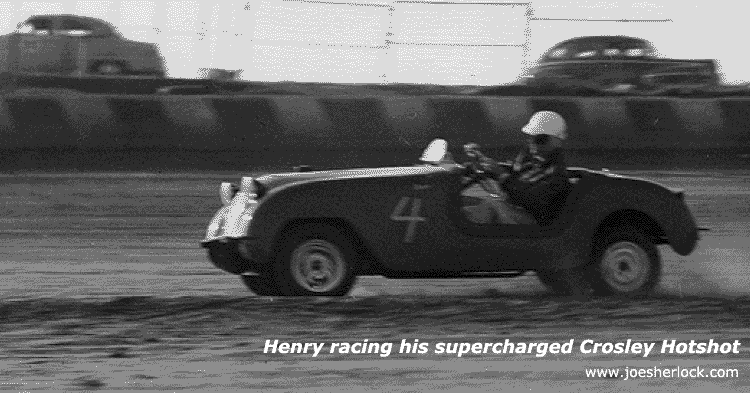
Mac continues, "Perhaps the Hotshot's proudest moment in production form was in the inaugural race at Sebring in 1950, then six hours rather than the traditional 12. There, a stock Hotshot owned by Tampa Crosley dealer Vic Sharp and driven by Bob Deshon and Fritz Koster won an unlikely overall victory, which was based on an Index of Performance formula. But the Crosley performance legend doesn't end there. All through the 1950s, Crosley ruled the H Modified, 750 cc category in SCCA sports car racing, supplying the engines and drivetrains for countless Crosley-based homebuilts. At vintage road racing events to this day, it's rare not to see a Crosley special or two."
Over a four-year period, Crosley produced a total of 2,499 Hotshots and Super Sports (the Hotshot's slightly better-trimmed twin). (posted 8/8/18, permalink)
Auto Industry Quote Of The Century … so far, is from the prolific Jack Baruth on the domestic auto industry: "Competition is bloodthirsty and margins in the business are low, although they tend to rise in lockstep with the ground clearance of whatever is being sold at the moment."
Jack added, "The automakers are also addicted to the speedball-like combination of "free trade" (that mostly favors China) and "free movement of labor" (that mostly favors low-wage countries). It's a hell of a business model: You buy your parts from China for dirt cheap thanks to currency manipulation and you do your assembly in Mexico for half-price and then you sell the product in the United States for debt-based American dollars. It literally cannot be a permanent business model, any more than a game of Monopoly can be, but that doesn't bother executives with an ADHD quarterly approach to profits."
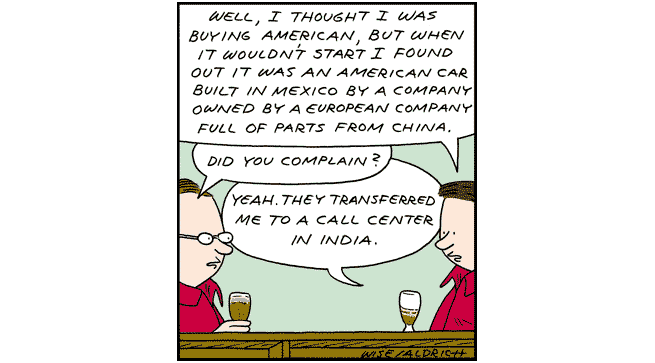
Automakers like to bitch and cry wolf every time the government does something they don't like. Detroit sang the same tiresome protest song in the 1970s about pollution controls. Lee Iacocca and Hank-the-Deuce used to perform perfectly-choreographed sad, self-pitying duets at every press conference they held. Meanwhile, Honda hummed quietly to itself as it developed the efficient, low-emission and innovative CVCC engine. The '75 Honda Civic's engine met the tough 1975 federal emission standards without a catalytic converter. It forced American car manufacturers to stop whining about government regulations and build better cars. If Honda hadn't built the Civic, Ford and GM would probably still be trying to sell us crappy Pintos and Vegas, perhaps with elevated ground clearances and AWD.
The nice thing (perhaps the only nice thing) about regulations is that they're a great equalizer - every auto company has to meet the same standards. Every time CAFE is raised, Detroit execs carp, bitch and whine. Meanwhile Honda and Toyota quietly develop innovative solutions to meet changing regulations - something they've been doing for 40-plus years (see my 2002 'Open Letter To Detroit' for more details).
In the early 1980s, Detroit's Big Three manufacturers lobbied Congress and the White House to take steps to reduce surging sales of Japanese auto imports, insisting there was a need for a "level playing field." Japanese manufacturers responded by building U.S. plants and kicking Detroit's ass even harder.
Fast-forward to today: GM Chairman and CEO Mary Barra is whining about trade tariffs. A statement released by General Motors predicted that "increased import tariffs could lead to a smaller GM, a reduced presence at home and abroad for this iconic American company, and risk less - not more - U.S. jobs." Yada. Yada. Like there were no jobs lost when GM moved some U.S. production to Mexico. Or Korea. Or China.
If America gets true free/fair trade, American-made automobiles may have a decent shot at some foreign markets. It used to be that way. Take a look at the Instanbul scenes in the 1963 James Bond flick 'From Russia With Love'. You'll see lots of American cars traveling the streets of the city. Ali Kerim Bey, head of the British Secret Service's 'Station T' in Istanbul, drove a 1960 Ford station wagon. Even today, Jeep Wranglers and Grand Cherokees, Chrysler minivans and Mustangs can be seen on the streets of Europe. Even Greenland and Iceland are dotted with U.S.-branded full-size pickup trucks and SUVs. (posted 7/17/18, permalink)
Second Act: The little, Korean-made Buick Encore crossover was introduced in 2015. And heavily advertised - I've seen more commercials for this model than any other Buick - clearly aimed at the female market. Now that I think of it, I haven't seen TV spots for any other Buick offerings.
Mark Baruth observed, "Nearly 50% of all Buick volume is the Encore, which sets new sales records every year and is on pace to do so again in 2018." Unfortunately, Buick heavily subsidizes the ... (more >>>)
City Of Parks (and a sports car or two): To many, Philadelphia is known as the City of Parks. Look around certain spots and you'll find greenery everywhere: Fairmount Park, Cobbs Creek Park, Pennypack Park ... (more >>>)
Shifting Perceptions: In an article titled 'Plate Tectonics of the Prestige Drift', Jack Baruth opined that Ford Explorers have better peer-prestige among oldsters than Chevy's SUV offerings.
Back in the 1950s, the low-priced three each had their own fans: "I'm a Ford man and always will be" or a similar mantra for Chevrolet or Plymouth. In those days, if you got a big raise, you could move up to a Mercury, Pontiac or Dodge to raise your status in the 'hood.
Now, the entire mid-priced field has disappeared, replaced by entry-level luxury. And well-optioned, pricey SUVs. Why is a Ford badge held in higher regard than a bow-tie in the SUV game? Jack, as well as various commenters have offered opinions: Ford doesn't import base models from Korea, Ford never took a bailout during the Great Recession, more conservative 'upscale' styling, better finished interiors and so on.
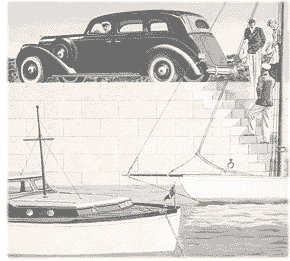 Jack wrote, "Today, brand image is slippery and hard to fix in place, like mercury or the value of a Bitcoin. It ebbs and flows on social media and celebrity involvement. It can be manipulated through a tie-in with the Kardashians or destroyed through vague slanderous blog-whispering the way that would-be Instagram competitor Vero was destroyed by oh-so-convenient allusions of sexism and racism that just happened to receive major play in media sources that had already invested heavily in the current order of things. Jack wrote, "Today, brand image is slippery and hard to fix in place, like mercury or the value of a Bitcoin. It ebbs and flows on social media and celebrity involvement. It can be manipulated through a tie-in with the Kardashians or destroyed through vague slanderous blog-whispering the way that would-be Instagram competitor Vero was destroyed by oh-so-convenient allusions of sexism and racism that just happened to receive major play in media sources that had already invested heavily in the current order of things.
Most of all, brand image is fragile now, more than ever before. The old generations, the people who are living in 7,000-square-foot plantation McMansions now, grew up as 'Ford men' or 'Chevy men' or even 'Toyota men'. Those preferences persisted through decades. We are on Internet time now. Today's Ford fanatic is tomorrow's Subaru loyalist. It's not good news. It means that more and more effort has to be diverted from engineering and testing to marketing and social media. It damages the product even as it tries to save it. It is nothing more or less than the way we live now." I've written more about branding and perception here.
Friends and acquaintances in my age group, who care about cars and are reasonably well-off, buy foreign luxury makes. Mercedes-Benz is the most popular choice; BMW a distant second. None of them own Lincolns or Cadillacs, although, when pressed, many admit that in their younger days, they lusted after a flashy Cadillac, such as an Eldorado. Fifty years ago, Cadillac owned most of the luxury automotive real estate. Today, foreign auto nameplates have captured over 80% of the U.S. luxury vehicle market. Cadillac is now outsold 2.5 to 1 by Mercedes-Benz.
Buick has zero luxury cachet among my friends. They don't even consider it a mid-priced vehicle anymore. Buick was once a proud brand driven by doctors and up-and-coming executives. Now it has become a transport for fixed-income, tight-fisted septuagenarians, who like to buy certified pre-owned examples.
Those geezer acquaintances who are not 'car people' have Toyotas somewhere in their garages. While none of my friends owns one, the GMC Yukon Denali seems pretty upscale, too.
What will the future bring for the prestige car market? Your guess is as good as mine. Although, I think it will always include a three-pointed star.
I've written more about the evolution of the luxury car market here. (posted 7/9/18, permalink)
Book Review: 'Jaguar From The Shop Floor: Foleshill Road and Browns Lane 1949 to 1978' by Brian James Martin
This is Mr. Martin's memoir of his time as a Jaguar employee. He began working there in 1949, during the early days of the XK120 sports car and left for good in 1978, after the execrable British Leyland took over the firm and the XJS touring car had been introduced as a replacement for the iconic E-Type sports car (much to the chagrin of sports car types). Even after leaving, Brian has stayed connected through his active membership in several Jaguar clubs.
Martin's stories provide a glimpse of the difficult overall conditions ... (more >>>)
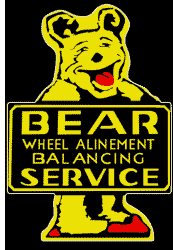 Bear Service: When I was growing up, the happy bear on the Bear Service sign was a familiar sight at auto repair shops. Bear Service: When I was growing up, the happy bear on the Bear Service sign was a familiar sight at auto repair shops.
Unbeknownst to me, the firm also had a presence at the Indy 500: "The Bear Manufacturing Co. of Rock Island, Illinois, for over four decades set up its state of the art wheel alignment equipment near the car garages in Gasoline Alley and offered wheel alignments to all car owners and crew chiefs."
Brothers Will Dammann and Henry Dammann, invented an electric starter for the Model T so auto owners could forgo their cranks. The founders moved to Rock Island in 1913, founding Bear Manufacturing to produce and sell the starter. The company was quickly successful. The starter was so popular that Henry Ford started making electric starters standard equipment, and the Dammanns' market disappeared.
The company then got into the design and manufacture of auto equipment. Bear equipment became the standard for diagnosis and repair of wheel, steering and frame alignment. Later the company expanded into auto safety equipment.
In 1972, the family-held firm merged with Applied Power Industries, Inc. In 1980, all manufacturing operations in Rock Island closed. Bear products are still made and sold by the SPX Corporation of Waukesha, Wisconsin. (posted 7/3/18, permalink)
Infrequently Seen: Jeff Koch wrote about the unfamiliar-to-many Edsel station wagon lineup in a recent Hemmings article.
Edsel offered three wagon models in 1958. All were on the Ford 116-inch wheelbase platform. (Mercury wagons had a 122-inch wheelbase.) The lowest-priced Edsel station wagon was the Roundup, a two-door model, based on the entry-level Edsel Ranger series and priced at $2,876. The Villager referenced in the Hemmings article was a Ranger-based four-door offering, available in 6-passenger ($2,933, 2,294 produced) or 9-passenger ($2,990, 978 produced) configurations.
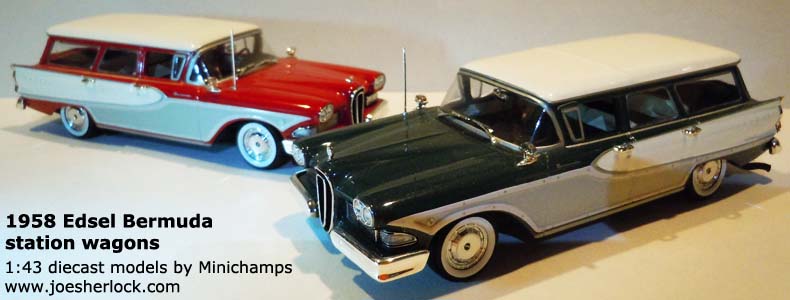
The more upscale Bermuda wagon was based on the higher trim-level Edsel Pacer. This four-door model was offered in 6-passenger ($3,190, 1,436 produced) or 9-passenger ($3,247, 779 produced) versions. (More information on the Edsel diecast models is posted here.)
Jeff wrote, "With only 978 produced, the 1958 Edsel Villager is one of the rarest station wagons on the road today. … Ford has to be credited for not just settling for the same-old same-old, inside or out, with the Edsel; the grille was controversial from the get-go, but inside, the stylists and engineers got together for a pair of interesting items that were beyond the standard-issue stuff for the era.
First was the barrel speedometer: Instead of a boring old needle swinging from left to right, the needle stayed steady while a revolving drum, its numbers clearly embossed into it, would match its number to the car's speed. None of this "I couldn't see the speedometer, officer!" nonsense; the number was in your face and right in front of you. As a bonus, it would glow if you exceeded a predetermined speed."
The second was the Teletouch push-button shift transmission. Now, pressing a button to shift wasn't new: Chrysler launched its "jukebox" TorqueFlite transmissions in 1956. Edsel's particular innovations, though, were two-fold. "First, the shift buttons were positioned in the center of the steering wheel where they could easily be located, saving you the trouble - and danger - of taking your eyes off the road to look somewhere on the instrument panel. Second, they were electric and required only a gentle press for the smooth-acting button to send the message to the transmission. When engaging, the sound is mechanical and positive, rather than the substantial clank you might hear under a comparable Mopar."
I've written about the predestined fate of the Edsel automobile here. (posted 6/13/18, permalink)
 Cubist Wisdom: Recently, Peter De Lorenzo of AutoExtremist wrote about Ford Motor Company's decision to cut most of its passenger car lineup, deleting the Fiesta, Fusion, and Taurus in favor of building more crossovers and SUVs. He remarked, "Why this news seemed to capture the media's fancy seemed a little odd to me, considering the fact that this was an American automobile company being proactive while anticipating and positioning itself to take advantage of market conditions that were destined not to change anytime soon. And I am quite sure if this was an imported car company declaring this step, the hand-wringing would be negligible to nonexistent. But then again this is Ford, and the mainstream media feels it is eminently qualified to weigh in on the matter, even if too many of its members are not." Cubist Wisdom: Recently, Peter De Lorenzo of AutoExtremist wrote about Ford Motor Company's decision to cut most of its passenger car lineup, deleting the Fiesta, Fusion, and Taurus in favor of building more crossovers and SUVs. He remarked, "Why this news seemed to capture the media's fancy seemed a little odd to me, considering the fact that this was an American automobile company being proactive while anticipating and positioning itself to take advantage of market conditions that were destined not to change anytime soon. And I am quite sure if this was an imported car company declaring this step, the hand-wringing would be negligible to nonexistent. But then again this is Ford, and the mainstream media feels it is eminently qualified to weigh in on the matter, even if too many of its members are not."
It is difficult to argue with Ford's reasoning. Over 40 years ago ... (more >>>)
Colorful Fords On Display: Patty Allison, of the site 'Imbued With Hues' digitally colorizes old black and white photographs and does a spectacular job bringing the images to life. I've written about her work before.
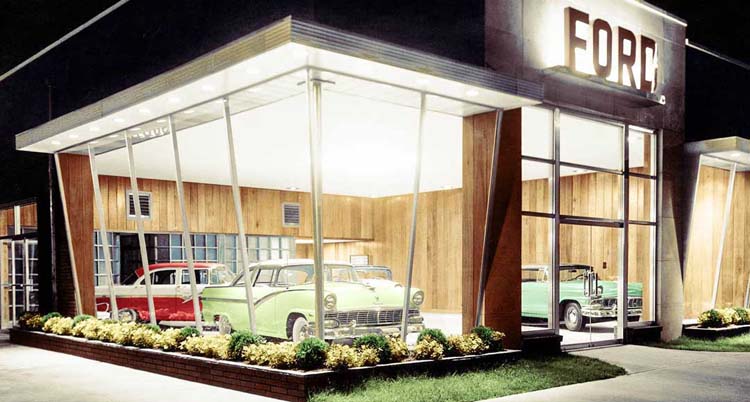
Recently, The Old Motor posted her redone photo of a small Ford dealer with four 1956 models on display in its wood-paneled showroom.
Ms. Allison "spends a considerable amount of time on each image she chooses to colorize by researching a vehicle’s original color combinations where possible, and then uses the right hues during the process. Her work results in photos that come to life and give us a colorful look back into the past."
The colors are so bright and fresh that the nighttime image looks like it was taken last week I have a certain fondness for 1956 Fords because I learned to drive in one. (posted 5/24/18, permalink)
Derham Body Co. - Coachbuilders To The World: Headquartered in Rosemont, PA (a Main Line suburb of Philadelphia), a custom coachbuilding company was founded by Irish wheelwright Joseph Derham in 1887 to make carriages for the well-to-do. As automobiles became popular, Derham provide bodies for cars for their wealthy clients. Derham quickly developed a reputation for fine quality, durable bodywork ... (more >>>)
When Economy Cars Were Cheap: Despite a recession year, Ford sold 223,763 little, four-cylinder Pintos in 1975. That's particularly amazing considering that the six-cylinder compact Maverick could be had for a few hundred dollars more.
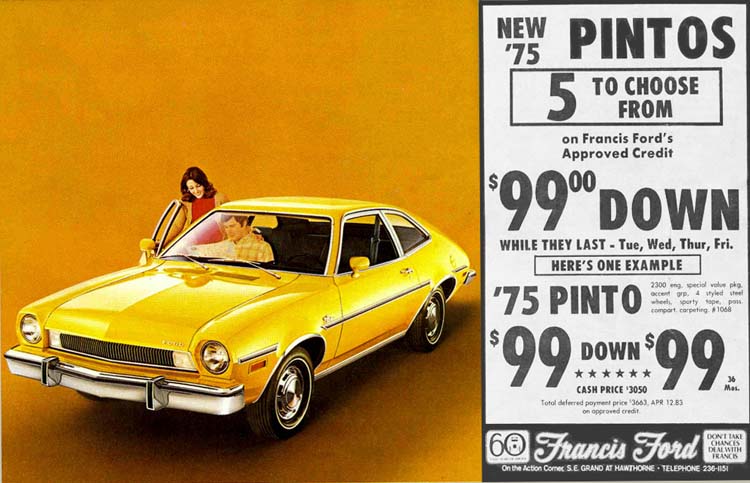
New '75 Ford Pintos were priced starting at $2,769 - that's about $13,000 in 2018 dollars. (A 2018 Kia Rio EX is priced at $18,700.) Francis Ford, a long-gone Portland, Oregon (it closed in 1982), offered new Pintos for $99 down and $99 per month for 36 months.
Pintos rode on a 94-inch wheelbase and made 83 horsepower in base form. I rented numerous Pintos in the 1970s, because they were similar in size to my VW Beetle daily drivers (1963 and 1967 models). I had no problems with any of my rented Pintos. But I never cared enough for them to buy one. (posted 5/8/18, permalink)
License Plates - Big & Small: Dave Burge has posited that a 1943 Wyoming license plate is "the standard by which all license plates shall be judged."
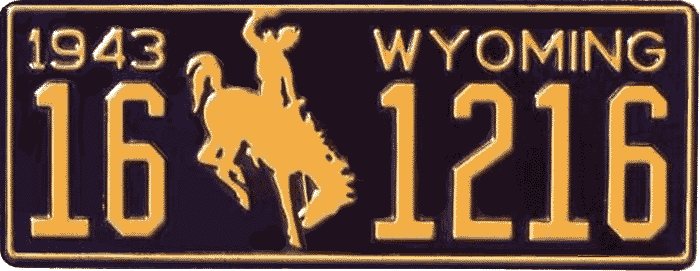
He added: "I prefer my license plates the way God intended: two-color enamel paint, embossed, and stamped by a convicted felon." France was the first country to introduce ... (more >>>)
Book Review: 'The Cars Of Harley Earl' by David W. Temple
This 192-page book covers Harley Earl the man as well as many of his influential cars. It is bipolar in that it covers neither the man nor his cars in complete detail, due to page limitations. I wish the photos were larger but the smaller photos are also a result of the book being designed to a price. Nevertheless, is it a very good read and provided me with ... (more >>>)
Texas Three-Step: Dave Burge posted photos of "the infinitely recursive supercharged Nash Metropolitan" from this year's Lone Star Roundup - the "best little hot rod show in Texas."

The white and yellow Metropolitan has a supercharged V8 engine with a yellow-and-white Metro-shaped air box topped by a scale model of the blown Nash. It's a very-cool triple-stack. (posted 4/24/18, permalink)
Autos Ordinaire: Lest you think that typical Philadelphia high-school students drove cool cars like those seen in 'American Graffiti', a 1958 photo of John Bartram High School, a public school in South West Philly, shows a collection of positively ordinary vehicles from the 1940s and '50s ... (more >>>)
 Sedan Death Watch: We are living in an SUV-crazed world. That's why the tiny Chevrolet Sonic, Ford Fiesta subcompact and full-sized Ford Taurus are on the chopping block. And rumors of the compact Ford Fusion's demise abound. As well as the full-sized Chevy Impala. Sedan Death Watch: We are living in an SUV-crazed world. That's why the tiny Chevrolet Sonic, Ford Fiesta subcompact and full-sized Ford Taurus are on the chopping block. And rumors of the compact Ford Fusion's demise abound. As well as the full-sized Chevy Impala.
First introduced as the top-of-the-line model for the 1958 model year, the Impala was Chevrolet's most expensive passenger model through 1965 and helped Chevrolet maintain its crown as the best-selling automobile in the United States from 1958 through '60 and '62 through '65, when the range-topping Caprice model appeared.
Ford debuted the Taurus for the 1986 model year. The Taurus' influential jellybean aero shape helped Ford recapture second place among domestic automobiles (it had dropped to #3 behind Oldsmobile in '85). In 1986, Ford sold 236,362 Tauruses. By 1988, Ford had become the top-selling domestic brand and the millionth Taurus was sold during the 1989 model year.
These former champions appear to be on their last legs. Meanwhile, Aston Martin's first SUV "will be launched next year into the ultraluxury SUV space where it will rival the Bentley Bentayga, Rolls-Royce Cullinan, Lamborghini Urus, a Ferrari SUV and high-end versions of the Range Rover." The five-door luxury SUV is expected to be called Varekai. Extended-wheelbase versions of luxury SUVs have replaced stretch sedan icons such as the Cadillac 75 and Lincoln Town Car L.
We live in strange automotive times, my friends. (posted 4/12/18, permalink)
Rare Sighting: In Chapter 13 (titled: The Wizard’s Challenge) of the 15-chapter movie serial, 'Batman & Robin', a 1941 Lincoln Custom makes an appearance, driven by the bad guys. The Custom was a special model - limited-production, long-wheelbase version of the Lincoln Zephyr.
The Lincoln Custom featured ... (more >>>)
 2018 Consumer Reports' Annual Auto Issue: Consumers Union began as a socialist organization in the 1930s and was once declared a subversive organization by the House Un-American Activities Committee. They still come off as a bunch of anti-capitalist lefties sometimes but Consumer Reports magazine remains the most comprehensive and believable of vehicle reliability surveys. 2018 Consumer Reports' Annual Auto Issue: Consumers Union began as a socialist organization in the 1930s and was once declared a subversive organization by the House Un-American Activities Committee. They still come off as a bunch of anti-capitalist lefties sometimes but Consumer Reports magazine remains the most comprehensive and believable of vehicle reliability surveys.
CR's database comes from "more than 640,000" vehicles owned by subscribers who fill out Consumer Reports' annual survey. That's only half as many vehicles that surveyed in 2012. Cars which are awarded the coveted Top Picks or Buy Recommendation now only need to score 'average' in reliability.
Here are some interesting tidbits from the magazine:
• The top-rated large car for 2018 was the Chevrolet Impala. Yet, the Impala is also listed as the least reliable in the eight and twelve year-old large car category. The Toyota Avalon is ranked tops in these categories.
• This year's top-rated brands are Genesis, Audi, BMW, Lexus and Porsche.
• The five worst-rated brands are Fiat, Jeep, Land Rover, Alfa Romeo and Mitsubishi.
• The brands that dropped the most in overall score are Buick (eight points) and Acura (six points) due to declining reliability. Once paragons of dependability virtue, Acura and Honda now have mediocre reliability ratings overall. Interestingly, the Koreean and China-made Buicks have better reliability ratings than the ones made in the U.S.
• The poorest road test scores went to the Jeep Wrangler and Mitsubishi Mirage ES, although the Mirage got really good fuel economy.
• Several Toyota models are on CR's Top Picks list and the reliability of Toyota and Lexus models remains quite high.
• I am surprised at the high prices for electric cars: the Chevrolet Bolt Premier cost over $43,000 and the Ford Focus Electric is priced at almost $41,000. By comparison, a Prius Hybrid runs from $20-$30,000, depending on the model.
• Specific models which score much worse than average in predicted reliability include all Alfa Romeos, Acura ILX, Buick LaCrosse, Cadillac Escalade, Chevy Corvette, Camaro and Suburban, Dodge Charger and Challenger, Ford Focus and Fiesta, GMC Yukon XL and Acadia Denali, anything with a Fiat badge on it, Jaguar E-Pace and F-Pace, Jeep Renegade and Grand Cherokee, all Land Rovers, Lincoln MKX, everything Maserati, Mercedes-Benz GLC and GLS, Mazda CX-9, Porsche Cayenne, all Range Rover models, Tesla Model X and Volvo XC90.
I continue to put much stock in Consumer Reports' comprehensive vehicle survey data analysis. I recommend that you pick up a copy of the April issue for reference while it's still available. (posted 3/27/18, permalink)
Brought To You ... By Electricity: Electric trucks are in the news these days. Tesla, Navistar and others are developing all-electric delivery trucks, while UPS is converting 1,500 of its delivery vans to electric operation. Navistar has been testing its electric vehicles, which boast a 100-mile range, tight turning circle, and up to 4,400-pound payload with Federal Express.
Electric trucks have been around for over 100 years, produced by such firms as Columbia, Walker Vehicle Co., CT Electric and Frederick R. Wood & Sons.
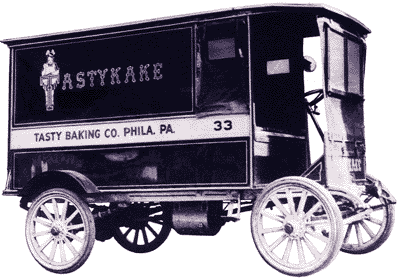 Bakeries (including Philadelphia's Tasty Baking Co.), express companies and breweries also ran electric fleets. Many department stores used electric trucks for city deliveries. John Wanamaker employed such vehicles for its New York and Philadelphia stores, many made by George W. Hoover & Sons of York, PA and Buffalo Vehicle Company of NY. In 1912, Gimbels boasted a fleet of 76 electric delivery wagons. Macy's had electric delivery vans as well. American Express had 300 electric vehicles in 1913. Brewer Jacob Ruppert ran a fleet of 72 electric delivery wagons in 1912. (Many were still in used in the 1940s; they were very popular during the war because of the war-rationed gasoline.) Bakeries (including Philadelphia's Tasty Baking Co.), express companies and breweries also ran electric fleets. Many department stores used electric trucks for city deliveries. John Wanamaker employed such vehicles for its New York and Philadelphia stores, many made by George W. Hoover & Sons of York, PA and Buffalo Vehicle Company of NY. In 1912, Gimbels boasted a fleet of 76 electric delivery wagons. Macy's had electric delivery vans as well. American Express had 300 electric vehicles in 1913. Brewer Jacob Ruppert ran a fleet of 72 electric delivery wagons in 1912. (Many were still in used in the 1940s; they were very popular during the war because of the war-rationed gasoline.)
Curtis Publishing Co. of Philadelphia had a fleet of 22 heavy-duty C.T. Electric flatbed trucks to haul tons of paper, coal for the printing plant, bulk tonnage of finished periodicals to the U.S. Post Office and supplies. They were also used for quiet, overnight delivery to newsstands throughout Philadelphia. The vehicles were made by Commercial Truck Company of America, located in Philadelphia. Curtis was one of the largest and most influential publishers in the United States during the early 20th century, producing 'Ladies' Home Journal', 'Saturday Evening Post', 'American Home', 'Holiday' and other popular magazines.
I once worked up the street from Curtis' impressive corporate headquarters, located about 200 feet southwest of independence Hall. I also remember seeing ancient, solid-tire electric trucks in downtown Philadelphia in the early 1970s, although they weren't from Curtis - the company retired the last of its fleet of CTs in 1964.
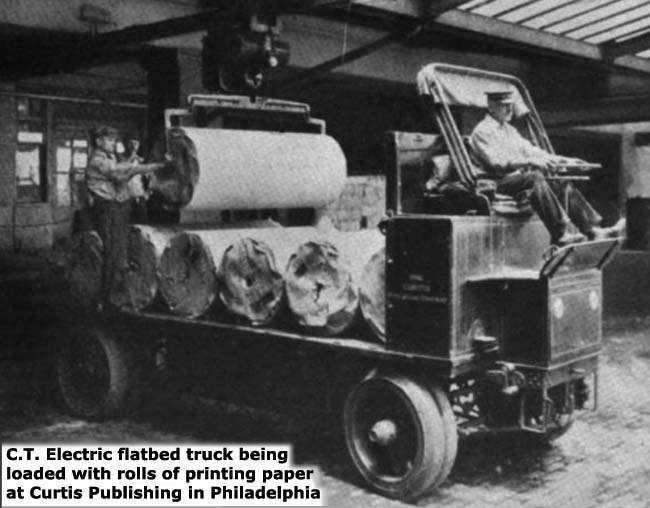
An electric ambulance made by F.R. Wood carried mortally-wounded President William McKinley from the Pan American Exposition's Temple of Music to the Exposition Hospital in Buffalo, NY on September 6, 1901.
'Electric Ambulance' sounds like the title of a vinyl LP album from the late 1960s. (posted 3/7/18, permalink)
Hello Seventies: The sleek 1970s Italian icon, the Stratos, is returning in updated form but it will not wear Lancia badges this time around.
The bulging-fendered, mid-engined black beauty is based on the 2010 concept car. The 2,800 pound rocket will be powered by a 550-horsepower engine of unspecified origin.
The new Stratos' front-fender bulges remind me of a mid-engine design I sketched in 1967. (posted 2/21/18, permalink)
"The Thickly-Cushioned Luxury Of Seats Covered In Rich Corinthian Leather." Recently, Mac's Motor City Garage published an article about the mid-1970s Chrysler Cordoba, proclaimed as The Car That Saved Chrysler.
First, a bit of history: The phrase Personal Luxury Coupe was unheard of in 1956. The name developed shortly after the wildly-successful four-seat Thunderbird arrived for the 1958 model year. General Motors management took notice and eventually entered the market segment with the 1963 Buick Riviera.
Later, Chevrolet decided to get a piece of the personal luxury coupe action with the 1970 Chevrolet Monte Carlo.
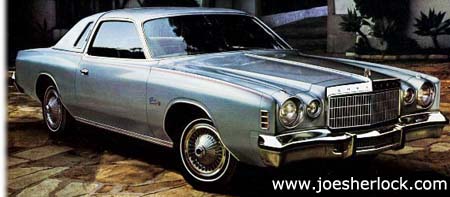 What eventually became the Chrysler Cordoba was originally planned as Plymouth's personal luxury coupe - its answer to the popular Monte Carlo. Chrysler management decided to make it a more upscale Chrysler model after experiencing alarming declines in sales of its flagship brand. What eventually became the Chrysler Cordoba was originally planned as Plymouth's personal luxury coupe - its answer to the popular Monte Carlo. Chrysler management decided to make it a more upscale Chrysler model after experiencing alarming declines in sales of its flagship brand.
"With some minor changes in trim, features, and badges, the Plymouth became the 1975 Chrysler Cordoba ... Billed as "the new, small Chrysler," the model sold more than 150,000 units in its first year, accounting for 60% of the division's total volume of 251,000 cars in '75." Buyers could also choose between interiors: classic '70s velour fabrics or the "rich Corinthian leather" as described by the suave actor Ricardo Montalbán in Cordoba commercials.
The Cordoba was quite successful in its day. Priced almost 20% higher than the Monte Carlo, the Cordoba was undoubtedly more profitable than the original Plymouth-badged proposal would have been. It sold in far greater quantities than the similarly-priced Mercury Cougar coupe - almost 140% more, probably because the public still perceived Chrysler as a more prestigious marque in those days.
Cordoba sales peaked in 1977, with over 183,000 examples finding buyers. Then came the Iranian Revolution-caused early 1979 energy crisis, the government bailout of a nearly-bankrupt Chrysler in late '79, the double-dip recession of 1980-82 and the public's new fascination with compact, economical cars.
All of those factors doomed the Cordoba. It didn't help that the boxier, second-generation 1980 model was based on the smaller Plymouth Volaré. In any case, Cordoba's sales began to slide in 1978 and continued downward until reaching a mere 12,471 units in 1983. That's when Lee Iacocca's 'New' Chrysler Corporation pulled the plug. Corinthian cattle everywhere rejoiced. (posted 2/15/18, permalink)
'Bullitt' - The Movie ... And More: Recently, Jack Baruth at The Truth About Cars favorably reviewed the classic 1968 movie, 'Bullitt' - the one with the spectacular CGI-free, 10-minute car chase.
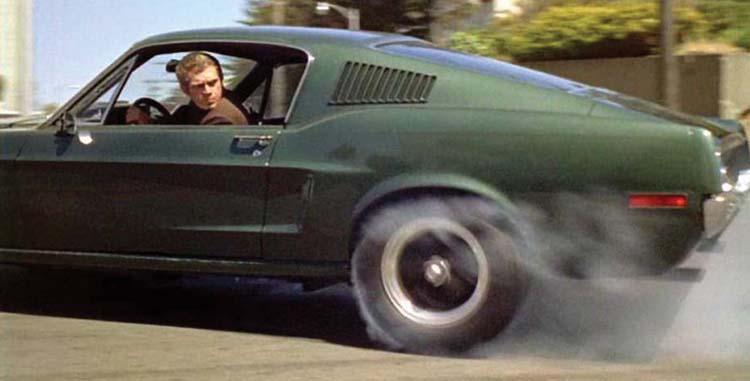
In addition to the awesome chase sequence, I enjoyed the movie on its own merits. The scenes were period-realistic, the characters were believable, and the acting was excellent. The casting seemed perfect. Robert Vaughn was well suited to play the oily and ambitious district attorney, Walter Chalmers. His two unnamed and uncredited butt-boy assistants looked like they were former fraternity members at Faber College's snooty Omega Theta Pi fraternity. They could have been roomies with Greg Marmalard.
Jaqueline Bisset made the perfect architect girlfriend for Lieutenant Frank Bullitt. Although Vic Tayback's part is small, he was a more believable mob boss than as diner owner in TV's 'Alice'. Norman Fell, best known as the hapless Mr. Roper on 'Three's Company', played the consummate prick, Captain Baker, while Simon Oakland was cast as Bullitt's gruff boss, Captain Sam Bennett.
Steve McQueen had quite a bit of input on the film since ... (more >>>)
Automotive Obesity: Several years ago, I wrote about automotive convergence. Small cars are getting larger (due to crash requirements and fatter buyers who need more interior room), while large cars are shrinking (due to better interior packaging efficiency and generally smaller - but more usable - trunks).
Kim du Toit provided examples of automotive bloat, comparing the original Mini with today's fatter version:
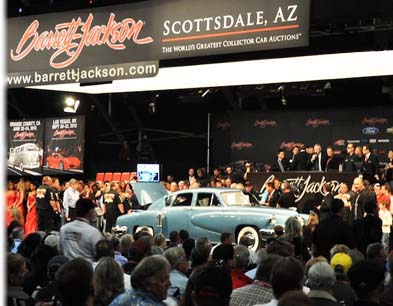 Arizona Money Show: As usual, the various Scottsdale vehicle auctions were full of aging white dudes with buckets of cash, bidding against each other, as they sought their automotive nirvana du jour. Or the nostalgia of their youth. Arizona Money Show: As usual, the various Scottsdale vehicle auctions were full of aging white dudes with buckets of cash, bidding against each other, as they sought their automotive nirvana du jour. Or the nostalgia of their youth.
Serious car collectors, such as someone who pays millions for a single vehicle, does not just have one collector car. Typically, he has a collection - 20 to 50 cars - and employs several mechanics just to care for them. Often, such folk own a tricked-out enclosed car carrier to transport their prized vehicles to shows. It's fair to assume that this person's collection is worth north of $30 million. That collectior is quite rich, probably worth a half-billion or more. This man is likely a first or second generation business owner, with a firm large enough to allow his sheet-metal indulgences, including the time off to travel to auctions and hobnob with other, like-minded collectors.
How old are these guys? Looking at the televised Barrett-Jackson events, I'd guess that the age of the average bidder was 50-70. Hemmings Motor News used to claim that its average subscriber was 52 years-old. By that age, the kids are out of college, the mortgage is shrinking (or paid off) and it's usually peak income time at work. All of that means there's disposable income to spend on various toys. Speaking of toys, other auto-related items fetched high prices this year. At Barrett-Jackson, a German-made 1957 Wilhelm Hennecke transportation-themed carousel (32 feet diameter, 16 feet tall) fetched $485,000, and 30-inch diameter, double-sided porcelain-enameled 1939 Husky Gasoline sign (Canadian) sold for $130,000.
Money-wise, prices are rising for most collectible cars; average sale prices increased almost 4%. Auction houses experienced an 84% sell-through rate - better than last year. At Mecum's January auction in Kissimmee, Florida, sales were up over 12% compared with last year. A 2015 Ferrari LaFerrari topped that auction, selling for $3.41 million.
There were, however, exceptions. Only half as many cars valued in the $2 million to $5 million range were sold this year. Gooding & Co. offered a red 1956 D-Type Jaguar. It failed to sell at a bid of $8.8 million. RM Sotheby's D-Jag was also a no-sale at $9.8 million.
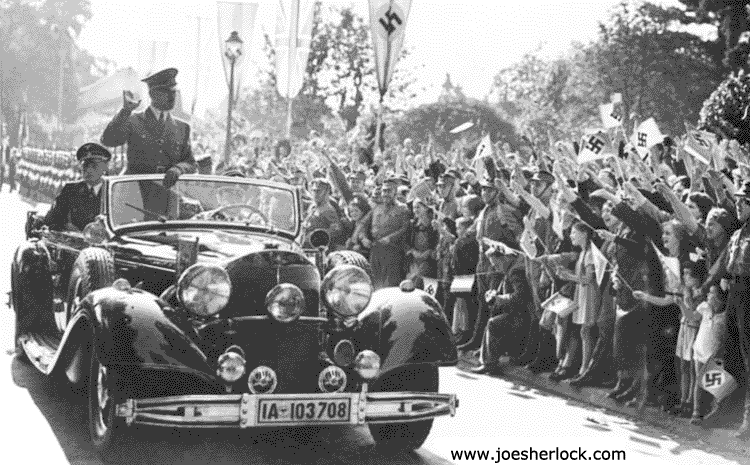
At Worldwide Auctioneers, a 1939 Mercedes-Benz 770K said to have carried Adolf Hitler during parades in Nazi Germany, failed to sell at a high bid of $7 million. One of five surviving Offener Tourenwagens, the big Merc was formerly part of the famed Imperial Palace Auto Collection. In my view, the problem with these no-sales is that over-optimistic (or overly greedy) sellers set unrealistically high reserve prices.
This year, aside from the usual multi-million-dollar exotics, muscle cars and vintage trucks pulled surprisingly high sale prices. It's impossible to cover the various auctions in their entirety, so here is a sampling of cars that I found interesting:
• A silver 1966 Shelby Cobra 427 S/C (one of 31 semi-competition models produced) fetched $2,948,750 at RM Sotheby's. The auction house also sold a silver 1948 Tucker 48 Sedan for $1,793,750.
• Bonhams gaveled a 1958 Porsche 550A Spyder works race car that placed fifth overall at Le Mans for $5.17 million. Bonhams also sold a 1972 Ferrari 365 GTS/4 Daytona for $2.64 million and a 1957 Mercedes-Benz 300SL Roadster for $1,512,500.
• At Gooding & Co., a gorgeous red 1954 Ferrari 500 Mondial roadster crossed the block for $4.455 million. And, a one of a kind, Pininfarina-bodied silver-blue (Acqua Verde Metallizzato) 1965 Ferrari 275 GTB Speciale with V12 power sold for $8,085,000.
I binge-watched almost all of Barrett-Jackson's televised Scottsdale auction. It was chock full of 1965-72 muscle cars, pony cars and Corvettes as well as over-restored old pickup trucks - former workhorses, now show horses. My eyes were drawn to some of the vintage passenger cars offered:
• Several Lincolns crossed the block this year. A rare 1942 Lincoln Continental coupe - one of 200 made during the war-shortened '42 model year - was finished in dark green and sold for $45,000. A black 1948 Lincoln Continental cabriolet (with red leather interior) fetched $54,000. These older Connies haven't budged much in price over the past 25 years. The market has moved on to muscle cars and demand for most non-coachbuilt '30s and '40s cars has generally stagnated. A black 1963 Lincoln Continental four-door convertible, sold for a whopping $130,000. Twenty years ago, a nice example of a slabside Lincoln convertible could be had for under $15,000. They have since rocketed an popularity and price. (Later, a black '64 four-door convertible sold for 'only' $69,000.) A dark blue 1956 Continental Mark II (with only 32,000 original miles on the odo) - a far rarer car than the '63 Lincoln - fetched $87,000. And a 1956 turquoise 1956 Lincoln Premiere convertible gaveled down at $100,000, even though its original price tag was about half that of the Mark II.
• In the world of old woodies, a 1931 Ford Model A station wagon once owned by Mary Tyler Moore went for a mere $24,200, while a black 1938 Ford station wagon sold for $47,000. A red 1948 Ford Super Deluxe wagon fetched $60,000. In 1948, Ford made 8,912 examples but most are long-gone. My uncle John once owned a Ford woody wagon of the 1946-48 era; he had to get rid of it when it became termite-infested.
• Some nice old Buicks found new buyers including two gorgeous 1953 Buick Skylark convertibles. A yellow example sold for $69,000, while a white one with a red leather interior fetched $160,000. Only 1,690 examples were produced and were originally priced at $5,000 - a lot of dough in '53. A white-over-red 1957 Buick Roadmaster convertible, with the iconic four Ventiports on each side, sold for $120,000. It stickered for only $4,066 in '57. Where's a time machine when you need one?
• Several vintage Cadillacs were at the B-J auction. A white '53 Cadillac Eldorado convertible with Continental kit fetched $165,000. 1953 was the first year for this expensive Caddy model; it was originally priced at $7,750 (more than five times as much as a '53 Chevy business coupe) and only 532 were made. President Eisenhower rode in one of these during his Inaugural Parade in D.C. Only 532 Eldos were produced in this first year. A 1957 black Cadillac Eldorado Biarritz convertible with red leather interior crossed the block at $200,000 and a black 1959 Series 62 convertible with red leather sold for $130,000. Finally, the notorious Car Pool, a light blue 1969 Cadillac de Ville with top and interior removed and replaced by a large, functioning hot tub, crossed the block for $24,000. The car was featured last season on 'Jay Leno's Garage'.
• A 1957 Studebaker Golden Hawk - gold with white fins - crossed the block at a bargain $45,000.

Meanwhile, another '57 model, an Oldsmobile 88 Fiesta four-door hardtop station wagon, fetched $105,000 - surprisingly high for a station wagon, although it was very nice-looking in blue and white. Speaking of Oldsmobiles, a white-and-red 1953 Fiesta convertible sold for $225,000. In 1953, this top-of-the-line model cost $5,717; that was Cadillac money in those days. Actually, it's more than Caddy money; you could get a new '53 Coupe de Ville for only $3,995. No wonder only 458 Fiestas found buyers in 1953.
• A 1963 Volkswagen 23-window Microbus, painted white over pale green, sold for an amazing $145,000 - a jump of over 30% compared with last year's VW Bus offerings.
• A Tweety Bird yellow 1970 Plymouth Road Runner hardtop coupe, with the 426 cu-in, 425 horsepower Hemi and 4-speed manual tranny crossed the block at $195,000. If anyone wants to buy my V8-powered Plymouth coupe for that price, it's yours.
A cream-colored Plymouth Superbird with black vinyl top and obligatory giant rear wing and long, droopy front nose found a buyer at $260,000, while a red '70 Hemi 'Cuda, with 7,350 original miles on the odometer, sold for $175,000. Speaking of Plymouths, the red, one-off 1954 Plymouth Belmont roadster concept car failed to sell at a high bid of $600,000. Finally, a 2000 silver Plymouth Prowler faux street rod sold for $30,000.
• A green 1970 Pontiac GTO Judge convertible with the Ram Air IV engine option fetched an astounding $400,000, demonstrating the muscle car fever which swept Scottsdale this year.
The auction biz seems to be doing well these days. Bidders are feeling flush, there are plenty of disposable dollars around and the collector car market is reflecting the overall economic optimism. And the very wealthy don't seem to have a care in the world. (posted 1/22/18, permalink)
Showtime: Not too long ago, the Detroit Auto Show was one of the best in the world. No more. There is too much competition. It must compete with shows in Tokyo, Shanghai, Los Angeles and even the Consumer Electronics Show in Las Vegas - all held within a relatively-short period. Once a showcase for electronic gizmos, CES has now embraced tech-laden, futuristic vehicles.
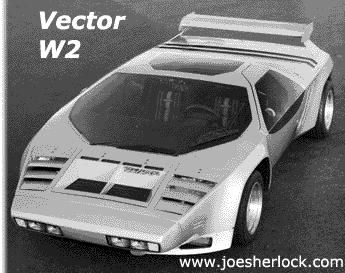 At an early-1980s CES, I saw only one car on display - the mega-hyped, never-produced Vector W2 mid-engined supercar, with its twin-turbocharged, 600 horsepower V8 motor. Top speed was claimed to be 242 mph. (In my opinion, the Vector was the Tucker of the late 20th Century.) At an early-1980s CES, I saw only one car on display - the mega-hyped, never-produced Vector W2 mid-engined supercar, with its twin-turbocharged, 600 horsepower V8 motor. Top speed was claimed to be 242 mph. (In my opinion, the Vector was the Tucker of the late 20th Century.)
There were numerous cars on display at the 2018 Consumer Electronics Show: Hyundai unveiled its Nexo fuel-cell vehicle (with a 370 mile range). Fisker showed off its swoopy EMotion electric vehicle. Chinese-backed car startup Byton officially unveiled its all-electric crossover.
The new Kia Niro EV was launched in Las Vegas, offering a range comparable to the Chevy Bolt and Tesla Model 3. Toyota showed its e-Palette concept van which features automated driving and 'mobility' - a word used a lot by automakers in 2018. As if we didn't have mobility before. What about feet? Or bicycles? Or roller skates?
Daimler debuted a self-driving electric Smart car. Venderhall Motor Works introduced an electric 3-wheeler trike, the Edison; it has a range of 200 miles on a single charge and an unoriginal name. The two-seater has a top speed of 105 mph and a 0-60 mph time of 4 seconds. Genovation unveiled the GXE, an 800 horsepower all-electric Corvette.
On the other end of the scale, the Ujet electric scooter made its debut; it offers 93 miles on a single charge for those who wish to actually endure 93 miles on a scooter of any kind. Oh, it's foldable, too.
These introductions happened one week before the Detroit Auto Show, taking some of the wind out of the Motor City's sails. The Detroit Show was more about trucks and navel-gazing. Peter De Lorenzo wrote, "Detroit isn't a 'retail' show like the Chicago show, where real people look over real vehicles to buy. And it's not a trendsetting show like the Consumer Electronics Show or even L.A., or a mainstream media-centric show like New York. Let's face it: the Detroit Auto Show is a metal and carbon fiber-filled dog-and-pony show staged more for industry players than anything else."
Pickups and utility vehicles dominated this year's North American International Auto Show (official name, although everyone still calls it the Detroit Auto Show). There was a revamped Chevrolet Silverado, a resurrected Ford Ranger midsize pickup, which is a lot bigger than the old Ford Ranger we used to know (What's next - a Chevy Luv the size of a Peterbuilt?), a new Ram 1500 (also available as a hybrid), the totally-redesigned Mercedes-Benz G-Class SUV (looking a lot like the old one), the new, tech-loaded 2019 Acura RDX crossover, a refreshed Jeep Cherokee with softened styling (think 1960 Buick versus '59), the BMW X2 small-but-pricey crossover and the very quick Lamborghini Urus SUV (making its North American debut).
The navel-gazing part of the show was about autonomous vehicles and mobility in general. Various executives mused that perhaps vehicle ownership is coming to an end, replaced by 'subscription services'. This is like having a coven of vegans give the keynote address at a meatpackers convention. Detroit is publicly shooting itself in the foot, in my view.
So what kind of non-truck iron was on display? Well, a new, even-more-Americanized 2019 Volkswagen Jetta sedan and a restyled Hyundai Veloster sorta-coupe. Ford offered up yet another iteration of the Bullitt Mustang, available this summer as a green-hued 2019 475-horsepower model for aging dudes who think they're Steve McQueen reincarnated. Kia introduced a very sleek, redesigned Forte compact sedan. Honda debuted a new, larger Insight hybrid, which is much better-looking that previous models. The 2019 Toyota Avalon debuted with a big in-your-face grille and lots of new features. The Avalon's prominent nose won the show's Jimmy Durante Lookalike Award.
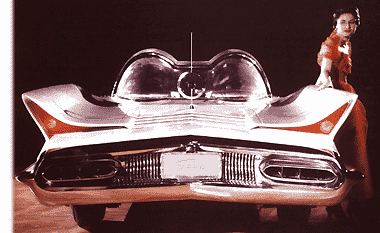 There was a smattering of concept cars on display, but nothing truly futuristic like the bubble-topped Lincoln Futura, the imposing yet unpredictable Packard Predictor or the outrageous, multi-finned, turbine-powered GM Firebird III of yore. There was a smattering of concept cars on display, but nothing truly futuristic like the bubble-topped Lincoln Futura, the imposing yet unpredictable Packard Predictor or the outrageous, multi-finned, turbine-powered GM Firebird III of yore.
The slinky four-door Infiniti Q Inspiration Concept sedan was on display at the show. It's a mid-sized four-door piece of eye candy, powered by a technically-interesting four-cylinder variable-compression turbo engine. Lexus debuted the large, tech-laden LF-1 Limitless luxury crossover concept. It has an oversized version of the dreaded Lexus spindle grille which is beginning to morph into a cowcatcher. This Lexus is not a looker to my tired eyes, despite the fact tham I'm a fan of old steam locomotives and, therefore, like cowcatchers.
The worst concept vehicle at Detroit was the Nissan Xmotion CUV-thingie, which is pronounced Cross-Motion. You know that, if they have to tell you how to pronounce its name, it's going to be a bad idea, unless Mel Brooks is somehow involved: "It's pronounced Frahn-ken-steen."
Several auto brands, including Audi, Cadillac, Chrysler and Lincoln, did not present any new vehicles, while Porsche, Jaguar and Land Rover skipped the Detroit show entirely. Which speaks volumes about the show's declining relevance. Better luck next year, Motown. (posted 1/18/18, permalink)
A Sign Of Things To Come: The Tucker Automobile Club has merged with AACA (Antique Automobile Club of America) Museum.
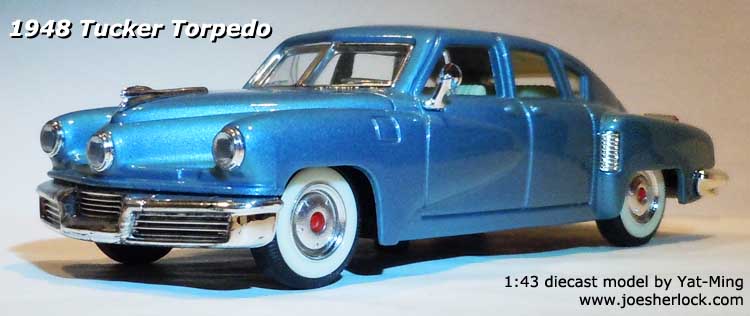
Eric Breslow, president of the Tucker Club echoed AACA Executive Director Jeff Bliemeister's assessment of the car club scene as a whole: "In my opinion, the car club model of the Seventies is dead and not coming back. Clubs are not what they used to be. The next generation is not interested in joining old-school car clubs."
Bliemeister also said he and other museum officials would like to form similar partnerships with other car clubs as they find themselves in similar positions to the Tucker club. "The possibility is there; we're open to any kind of partnership moving forward," he said. "Standalone clubs are dying, so we as a public museum want to do whatever we can to help out the hobby as a whole. And for us to house other marque clubs, that's how we're going to grow as a museum."
Sadly, Eric is correct. The old car culture is also undergoing gigantic changes. Many car clubs are suffering. The Lincoln & Continental Owners' Club has seen its membership rolls decline from over 5,000 in 1996 to a current number of 2,306. I belong to a regional car club which has experienced a steep decline in membership - dropping from 284 members at its peak in the 1990s to less than 100 today. But that's not the big problem - it's the volunteer pool which is drying up. Other car clubs I've belonged to have substantially shrunken and curtailed their activities. Or gone out of existence. A secondary problem is that some car clubs are inbred and not welcoming to new members. And do stupid things.
My experience is that people start buying old cars when they reach their mid-40s. That's when most guys start getting what economists call 'disposable income' and what we call 'pissing-around money'. I bought my first collector car when I was 44. I quickly joined two car clubs - both run by people in their mid-to-late 50s and populated by 40-somethings like me. Each club's 'elders' encouraged us to get active. We did and, by age 50 or so, we were running the club. The problem is that no one ever came along to replace us. There are few forty-somethings in these car clubs, despite aggressive recruitment efforts by club members. Those who do join aren't very active and have no interest in volunteering to help run a club. "No spare time," they plead.
An underlying problem is that today's 44 year-old graduated from high school in 1992, when cars were mostly crap. I've never heard anyone say, "I'm saving my money so I can someday buy a fully-restored '92 Buick Riviera. Or '92 Dodge Daytona. Or Geo Metro." Most don't have a high-school 'car dream' to chase - unlike people of my generation. I began buying car magazines when I was 12 years old. And spent a lot of time dreaming about what exotic car I'd like to own someday:
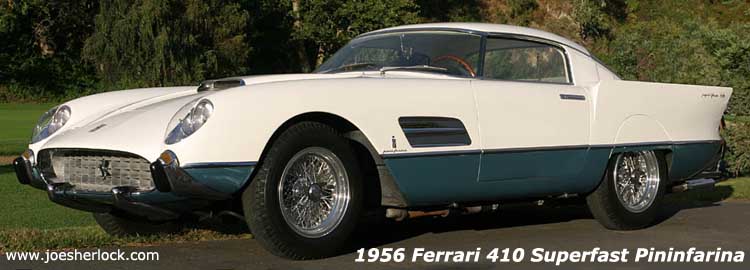
Today's forty-something is more likely to be spending any excess money on toys of the 1970s and '80s - old Fisher Price stuff, Merlin, Mr. Machine, a J. Chein litho roller coaster, Slip 'n' Slide, G.I. Joe stuff, Stretch Armstrong, Simon, Big Wheel, Green Machine, etc.
The dropping membership numbers reflect the general membership decline of most social and fraternal organizations in the U.S. - Elks, Masons, Eagles, etc. (No time to head down to the Moose Lodge to have a beer and make new friends - too busy doing social networking online - like updating your Facebook or Instagram page. Or saying something clever on Twitter.)
I have no solutions to offer here - just observations. (posted 1/10/18, permalink)
 2017 Auto Sales: In 2017, new U.S. vehicle sales were 17.2 million, marking the first decline after seven years of growth, capped by a record 2016. 2017 sales were down by about 2% overall. 2017 was the first year since 2009 in which auto sales failed to beat the previous year's. 2017 Auto Sales: In 2017, new U.S. vehicle sales were 17.2 million, marking the first decline after seven years of growth, capped by a record 2016. 2017 sales were down by about 2% overall. 2017 was the first year since 2009 in which auto sales failed to beat the previous year's.
Although 2017 sales volumes were kept afloat by sticker discounts, manufacturer incentives, cheap loans, cut-rate lease deals and a push into sub-prime financing, sales for 2018 are expected to decline because the U.S. vehicle market is quite saturated after several record or near-record years. There is also the expected influx of millions of nearly-new, off-lease vehicles that are cheaper than new vehicles.
Ford Motor Co. reported a U.S. sales year-over-over decrease of 1.1% for 2017. Sales totaled 2.587 million units compared with 2.615 million sold in 2016. Passenger car sales dropped 14.2% while sport utility vehicle sales rose 2.9% and truck sales rose 4.3%. The Ford brand declined 1.1% to 2,464,041 vehicles, while Lincoln was down 0.5% to 111,159 vehicles. Lincoln sold 12,012 Continentals in 2017 - an increase of 128% over 2016.
Ford's F-Series sales increased 9% with 896,764 trucks sold; this represents its best performance since 2005 and marks 41 consecutive years as America's best-selling pickup.
General Motors Co. posted total U.S. sales of 3.002 million units, a drop of 1.3% compared with 3.042 million units sold in 2016. Sales were lower in three of the company's four divisions - Buick, Cadillac and Chevrolet - but up in the GMC division. Cadillac sales declined 8% to 156,440 units; Buick deliveries were down 5% to 219,231 vehicles, Chevrolet sales dropped 2% to 2,065,883 units, while GMC sales were up 3% to 560,687 trucks and SUVs.
Fiat Chrysler Automobiles N.V. reported that 2017 sales fell 8% compared with 2016, from 2.244 million to 2.059 million units. Chrysler brand sales were down 19% to 188,545 vehicles, Dodge dropped 12% to 446,996 units, Ram truck sales increased 2% to 556,790. Once seen as the savior of Fiat-Chrysler, sales of the Jeep brand dropped 11% to 828,522 units. For the full year, Jeep Grand Cherokee sales increased 13%. Fiat sales fell 19% to 26,492 vehicles. Alfa Romeo sold 12,031 units in 2017.
Toyota sales declined 1% to 2,434,515 vehicles, while Lexus sales were down by 8% to 305,132 in calendar year 2017. Prius sales dropped 20%; Avalon sales were down 32%. Sales of the flagship Lexus LS sedan fell 26%.
The Honda brand was up 1% to 1,486,827 vehicles, while Acura dropped 4% to 154,602 vehicles.
Nissan sales rose 1% to 1,440,049 units; Infiniti jumped 11% to 153,415 vehicles.
Hyundai was down 13% to 664,961 vehicles, while Kia declined 9% to 589,668. Genesis sold 20,594 cars in 2017.
Mazda was down 3% to 289,470 vehicles. Back-from-the-Dead Mitsubishi sales rose 6% to 103,686 vehicles. Volkswagen increased sales 5% to 229,676 VWs in 2017. Mini was down 10% to 47,105 units, while Smart dropped a whopping 51% to 3,071 cars - only 166 found buyers in December. Smart had the dubious distinction of experiencing the largest sales decline in 2017.
Subaru sales were up 5% to 647,956, Subaru declared, "Best. Year. Ever."
Luxury automaker Bentley sales were down 7% to 2,405 vehicles, while Jaguar leaped 27% to 39,594. Audi sales increased by 8% to 226,511 units.
Tesla's estimated sales were up 35% to 55,120 vehicles but Tesla delivered only 1,550 Model 3 EVs in the fourth quarter - far below forecasts.
Mercedes-Benz sales increased very slightly to 375,240 - enough to make it America's top-selling luxury vehicle. Porsche sales were up 2% to 55,420 units. BMW sales declined 2% to 305,685 vehicles. BMW sold 100,000 electric vehicles in 2017, mostly in Western Europe and the U.S. Most were the i3 two-door compact coupe. Maserati sales increased 9% to 13,697 vehicles. Land Rover was up 1% to 54,379 SUVs.
Despite various ups-and-downs, 2017 was a very satisfactory year overall for manufacturers, OEM suppliers and dealers. (posted 1/4/18, permalink)
Earlier Car Musings can be found here.
Other Pages Of Interest
| blog: 'The View Through The Windshield' |
| greatest hits: various essays & articles | blog archives | '39 Plymouth | model train layout |
| about me | about the blog | e-mail |
copyright 2018 - Joseph M. Sherlock - All applicable rights reserved
Disclaimer
The facts presented in this blog are based on my best guesses and my substantially faulty geezer memory. The opinions expressed herein are strictly those of the author and are protected by the U.S. Constitution. Probably.
Spelling, punctuation and syntax errors are cheerfully repaired when I find them; grudgingly fixed when you do.
If I have slandered any brands of automobiles, either expressly or inadvertently, they're most likely crap cars and deserve it. Automobile manufacturers should be aware that they always have the option of trying to change my mind by providing me with vehicles to test drive.
If I have slandered any people or corporations in this blog, either expressly or inadvertently, they should buy me strong drinks (and an expensive meal) and try to prove to me that they're not the jerks I've portrayed them to be. If you're buying, I'm willing to listen.
Don't be shy - try a bribe. It might help.
| |